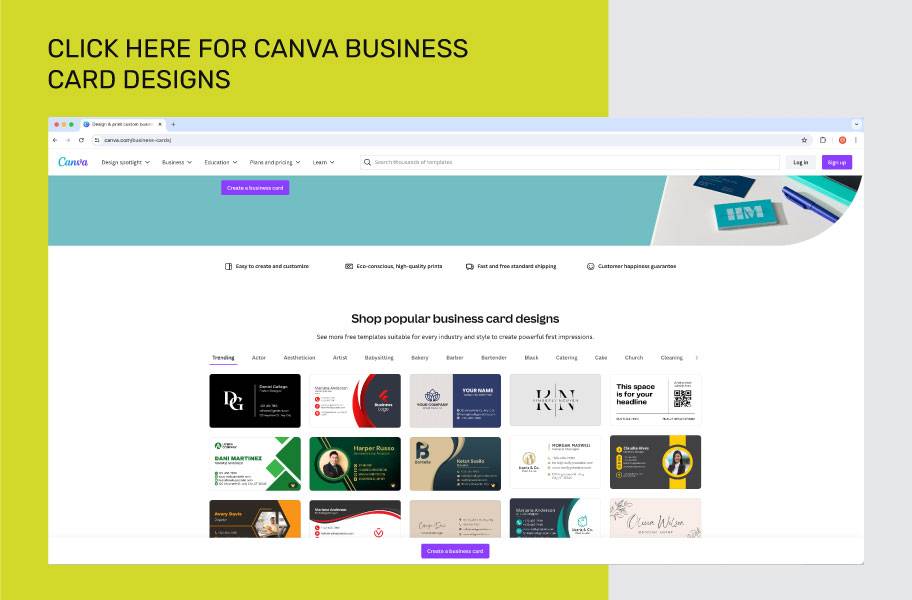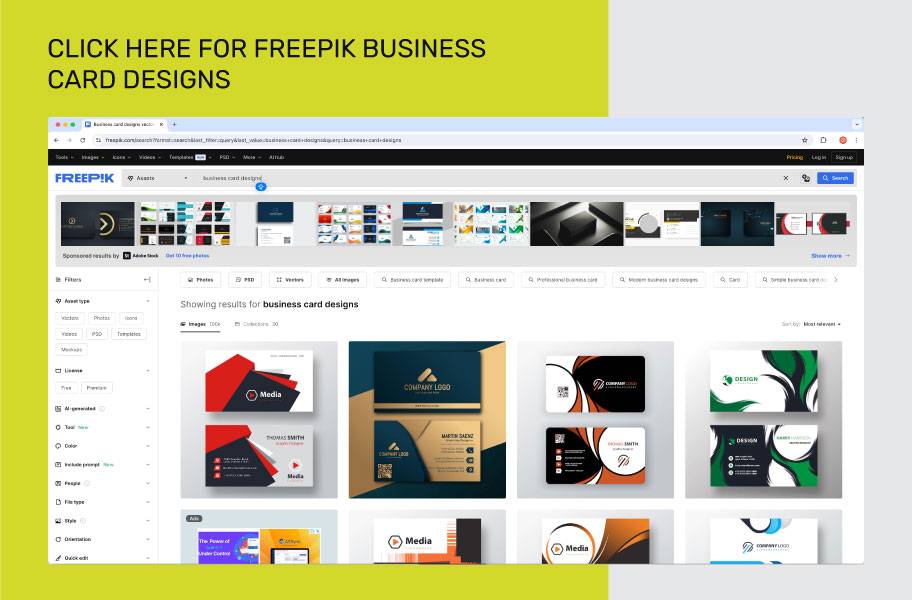
Business Card Design Do’s and Don’ts
In today’s business world, where digital communication is often the norm, business cards may seem like a thing of the past. However, a well-designed business card can still make a powerful impression and serve as a physical reminder of your brand and contact information. In this article, we will explore the dos and don’ts of business card design to ensure that your cards stand out for the right reasons
The Importance of Business Card Design
First impressions matter in the business world, and your business card is often the first physical impression that you make on potential clients or business partners. Therefore, it is crucial that your business card design is memorable, professional, and reflective of your brand identity. A poorly designed business card can give off the wrong impression and damage your credibility, which is why it is essential to understand the dos and don’ts of business card design.
When it comes to designing your business card, there are several factors to consider. The layout, colour scheme, font choice, and overall aesthetic should all work together to create a cohesive and visually appealing design. It’s important to strike a balance between creativity and professionalism, as you want your business card to stand out while still conveying a sense of competence and credibility.
Another important aspect of creating a good first impression with your business card is the quality of the materials used. Cheap, flimsy paper or a poorly printed design can give off a negative impression and make it seem like you don’t care about the details. Investing in high quality materials and printing for your business card printing will show that you take your business seriously and are willing to invest to make a good impression.
Reflect on Your Brand Identity
Your business card should reflect your brand identity and values. This means that the design, colour scheme, font choice, and overall aesthetics of your business card should match your brand’s look and feel. This will help establish consistency and increase brand recognition, which is essential for building a strong and professional business image.
When designing your business card, think about the message that you want to convey to potential clients or partners. Are you a fun and creative company, or a professional one? Your business card should reflect this message and help communicate your brand’s personality and values.
The Do’s of Business Card Design
Business cards are an essential tool for networking and making connections in the business world. They provide potential clients and business partners with a tangible reminder of who you are and what your business offers. However, designing an effective business card requires careful consideration of several key factors.
Choosing the Right Size and Shape
When choosing the size and shape of your business card, it’s important to consider both aesthetics and practicality. A larger card may allow for more design elements and information, but it may not fit easily into a wallet or cardholder. On the other hand, a smaller card may be more convenient to carry, but it may not leave enough room for all the necessary details.
One way to strike a balance is to choose a standard size and shape, such as a rectangular card that measures 90mm by 50mm. This size is easy to store and fits into most cardholders, while still providing enough space for your logo and contact information.
Selecting the Appropriate Colour Scheme
Colour plays a powerful role in branding and can help communicate your business’s values and personality. When selecting a colour scheme for your business card, consider the emotions and associations that different colours evoke. For example:
- • Blue is often associated with trust, security, and professionalism
- • Red can imply passion, urgency, or excitement
- • Green is often associated with growth, health, and nature
Choose colours that align with your brand’s personality and values, and use them consistently across all your marketing materials.
Incorporating Your Logo and Branding Elements
Your logo and other branding elements are key components of your business card design. They help establish brand recognition and create a consistent visual identity across all your marketing materials.
When incorporating your logo and branding elements, be sure to use them in a way that complements the rest of the design. Avoid using too many different fonts, colours, or graphic elements that can make the card look cluttered or confusing.
Utilising Readable Fonts and Typography
The typography you use on your business card should be easy to read and understand, the fonts layout is esential to keeping a potential clients attention . Avoid using overly decorative or stylized fonts that can be difficult to read, especially in smaller sizes.
Instead, choose a font that is clear and legible, and use font sizes and weights to create a hierarchy of information. For example, your name and job title may be in a larger, bolder font, while your contact information is in a smaller, lighter font.
Including Essential Contact Information
Your business card should include all the essential contact information that potential clients or business partners need to get in touch with you. This contact information include:
- • Upload your logo
- • Your name (What you prefer to be called)
- • Your job title & qualifications
- • Add your email address
- • Your phone number
- • Your company website
- • Other contact information
Make sure this information is easy to find and read, and avoid including any unnecessary details that can clutter the card. Ensure that your artwork is print ready (Check out our print-ready artwork checklist here)
Adding a Call-to-Action or Unique Selling Proposition
One way to make your business card stand out from the rest is to include a call-to-action or unique selling proposition. This can encourage potential clients or business partners to take action and follow up with you.
For example, you could include a discount code or special offer that is only available to those who receive your business card. Or, you could include a call-to-action that encourages recipients to visit your website or schedule a consultation.
By following these dos of business card design, you can create a professional, effective, and memorable card that helps you make valuable connections in the business world.
Use a free Freepik or Canva business card template to Design your business card quickly


Here are some other how-to videos and design tools to create your business cards:
- • how to design a business card (Coming Soon)
- • how to design a business card in photoshop
- • how to create a business card indesign
- • how to design a business card in illustrator
- • how to create business card in coreldraw (Coming Soon)
- • how to put facebook on business card
- • how to put instagram on business card (Coming Soon)
- • how to design a business card in word
- • how to make a business card in excel
- • how to make business cards in powerpoint
The Don’ts of Business Card Design
Avoiding Clutter and Overcrowding
Avoid overcrowding your business card with too much information, graphics, or other elements. This can make your card look cluttered and unprofessional, and make it difficult for individuals to find important information on the card.
When designing your business card, it’s important to remember that less is often more. You want to make sure that your card is easy to read and visually appealing. Stick to the essentials, such as your name, title, and contact information. If you have a logo, include it, but don’t add too many other graphics or design elements that may distract from the important information.
Steering Clear of Low-Quality Materials and Printing
Make sure that your business card is printed on high-quality materials and with a high-quality printing process. Low-quality cards may give off the impression that your business is cheap or unprofessional. Additionally, low-quality cards may not be as durable and may not make a good impression over time.
When choosing the materials for your business card, consider options such as heavy cardstock or even plastic. These materials will not only look and feel more professional, but they will also last longer and make a better impression on potential clients or customers.
Resisting the Temptation to Use Generic Templates
It may be tempting to use generic templates or designs for your business card, but this can hinder your brand recognition and make it difficult for your business to stand out from the competition. Instead, utilize your brand identity and design your own unique business card that reflects your brand’s image and values.
When designing your business card, think about your brand’s colours, fonts, and overall aesthetic. Use these elements to create a card that is not only visually appealing but also memorable and reflective of your brand. This will help your business card stand out from the rest and make a lasting impression on potential clients or customers.
Not Forgetting About the Back of the Card
While the front of your business card may get the most attention, don’t forget about the back of the card. Utilise the back to include additional information, such as a tagline or a list of services offered. Just make sure that the back is not too cluttered and is still easy to read.
Another way to use the back of your business card is to include a call to action. This could be a special offer or promotion, or simply a request to visit your website or social media pages. By including a call to action, you can encourage potential clients or customers to take action and engage with your business further.
Creating a well-designed business card is essential in establishing a professional and credible image for your brand. By following these dos and don’ts of business card design, you can ensure that your business card stands out for all the right reasons and makes a positive impression on potential clients and business partners.
FAQs about business card design
How much for business card design?
Printulu charges just under R400 for a business card design
Read More:
Free Business Card Template Designs You Can Customise Online
How to Print Business Card Size in Word
How are Business Cards Printed?
Where can I Print Business Cards



